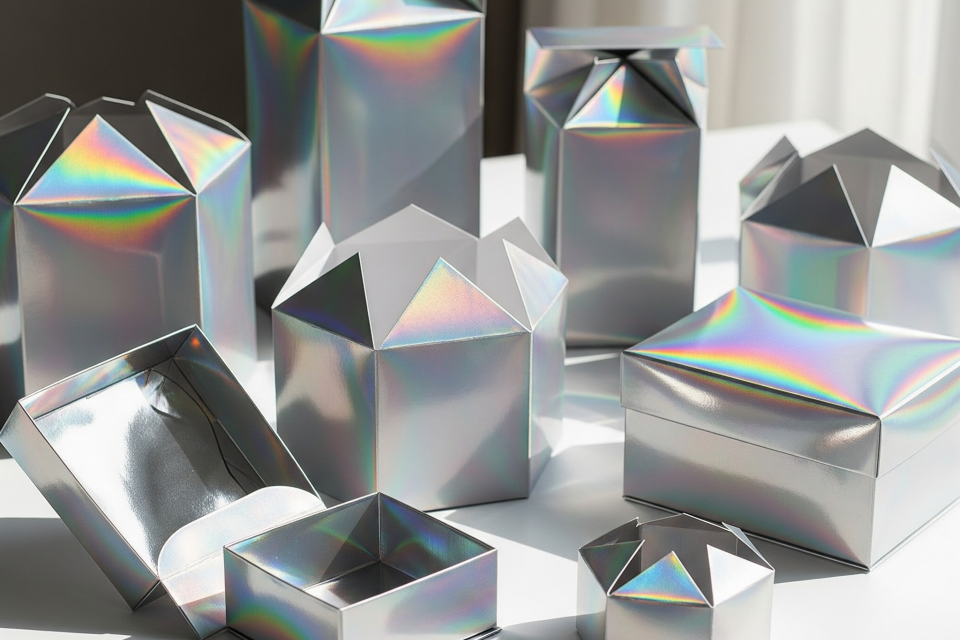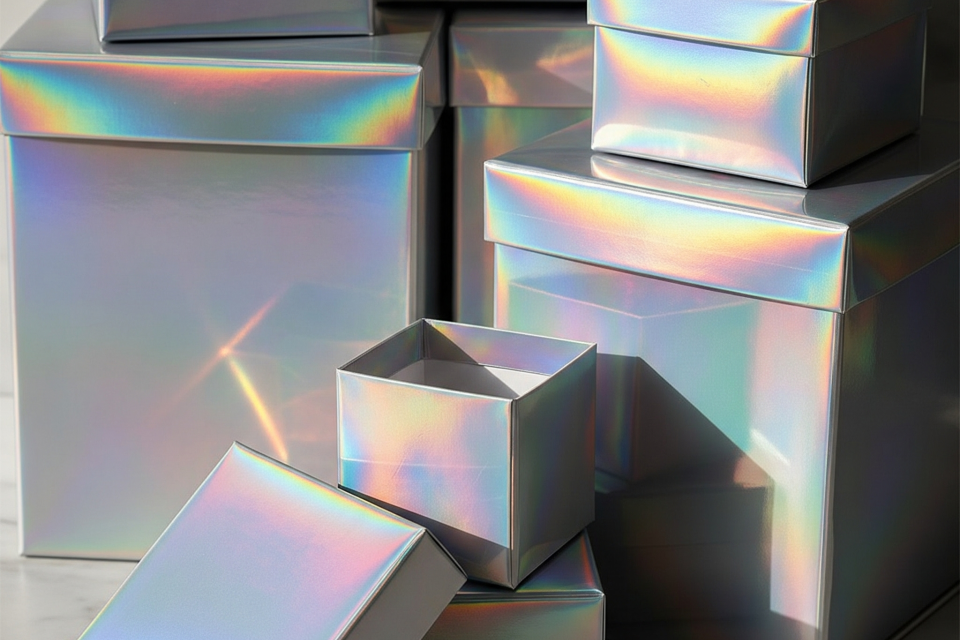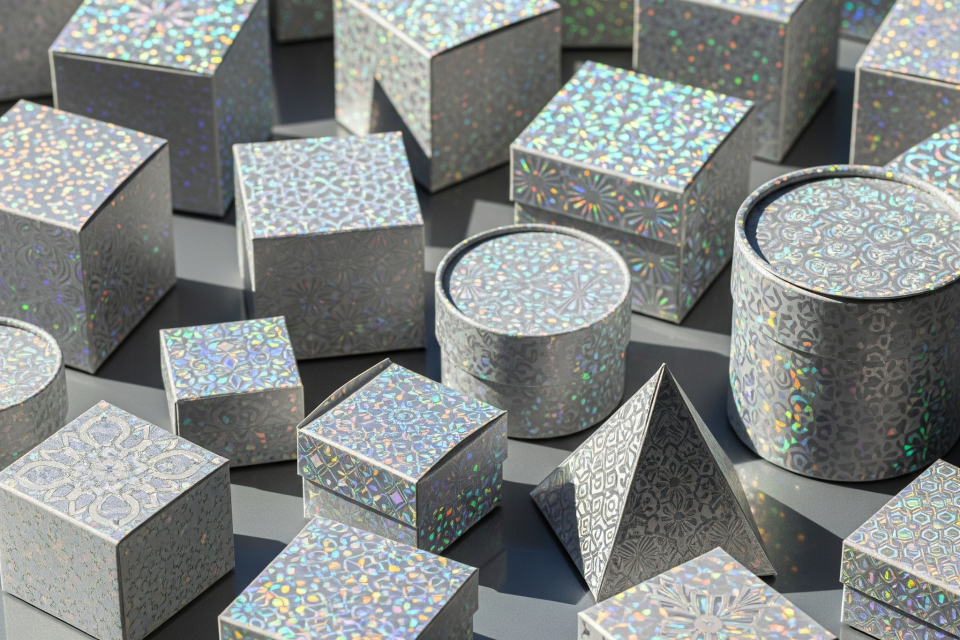The Holographic Packaging Trend
The Holographic Packaging Trend
Summary
The holographic packaging trend refers to the innovative use of holography in product packaging to enhance aesthetics, security, and consumer engagement across various industries. Originating from the foundational theories developed by British scientist Dennis Gabor in the 1940s, holography gained practical application in packaging by the 1980s, offering brands a novel approach to differentiate their products and deter counterfeiting efforts. This trend has become particularly notable as it reflects broader consumer demands for visually appealing, secure, and eco-conscious packaging solutions in a competitive market.
Holographic packaging is widely adopted in sectors such as pharmaceuticals, fashion, food and beverages, cosmetics, and electronics, with each industry leveraging its unique benefits. In pharmaceuticals, for example, holographic designs serve as a crucial anti-counterfeiting measure, directly impacting patient safety and trust. Similarly, the fashion and luxury goods sectors utilize holographic materials to elevate perceived product value, while the food industry benefits from enhanced preservation and safety features. The integration of augmented reality (AR) with holographic packaging further enriches consumer interaction, allowing access to promotional content and product information via smartphones.
Despite its advantages, the holographic packaging trend faces challenges, including high initial investment costs, technical complexities, and regulatory pressures. Smaller companies often struggle to adopt these technologies due to financial constraints and the need for specialized knowledge. Additionally, the industry's consolidation through mergers and acquisitions poses risks to competition and innovation, which could impact the diversity of available products.
Looking ahead, the holographic packaging market is anticipated to grow significantly, driven by technological advancements and an increasing demand for sustainable solutions. As consumer awareness about product authenticity rises, the need for innovative packaging incorporating holographic technologies is expected to expand, particularly in emerging markets. Brands are also prioritizing eco-friendly initiatives to align with changing consumer preferences, emphasizing the importance of sustainability in the future of holographic packaging.

History
Holography, the technique of recording and reconstructing light fields, dates back to 1947 when British scientist Dennis Gabor developed the foundational theory while working to improve the resolution of an electron microscope. He coined the term "hologram" from the Greek words "holos," meaning "whole," and "gramma," meaning "message". However, progress in the field was slow for the next decade due to the lack of suitable coherent light sources until the advent of the laser in 1960, which enabled practical holography by providing intense, monochromatic light.
The first practical applications of holography emerged in the 1960s and 1970s, including use in data storage and optical security features. The introduction of laser technology opened new avenues for the creation of various types of holograms, such as transmission and reflection holograms. In the 1980s, interest in holography surged, particularly with the incorporation of holograms in commercial products, including packaging. Holographic packaging began to gain prominence as brands sought innovative ways to enhance their product presentation and deter counterfeiting.
By the mid-1980s, notable projects like the eagle hologram featured on the cover of the March 1984 issue of National Geographic demonstrated the potential of holographic technology in mass production. Since then, holographic packaging has evolved significantly, becoming a staple in luxury goods and high-end products, utilizing both hot foil stamping and cold foil printing processes to create visually striking designs. As technology progressed into the 21st century, the emergence of digital holography further expanded the scope of holographic applications, promising advancements in areas like medical imaging and data storage. Today, holographic packaging not only serves aesthetic purposes but also incorporates anti-counterfeiting measures and eco-conscious options, reflecting the ongoing evolution of the holographic packaging trend.
Applications
Pharmaceuticals
The pharmaceutical industry heavily relies on holographic packaging to combat counterfeiting and ensure the integrity of medications. The need for secure and tamper-proof packaging is critical in this sector, as it directly impacts patient safety and product reliability. Holographic designs serve as an important deterrent against imitation, helping to build trust among consumers and healthcare professionals.
Fashion and Luxury Goods
The fashion industry utilizes holographic packaging to convey luxury and exclusivity. Holographic lamination films are increasingly being applied to clothing labels and accessory packaging, enhancing the perceived value of products and creating a memorable unboxing experience for consumers.
Food and Beverages
In the food and beverage sector, holographic packaging is utilized to improve product preservation and shelf life. Holographic blister foils are commonly adopted for their effective tamper-evident features, ensuring product authenticity and safety for consumers. Additionally, innovative solutions like the PaperSeal tray have emerged, which significantly reduce plastic waste while maintaining the quality of fresh and processed food items. The integration of augmented reality (AR) with holographic films also allows consumers to interact with product labels through smartphones, accessing promotional content and tutorials, thus enhancing the overall consumer experience.
Cosmetics
In the cosmetics sector, holographic packaging is employed to create visually appealing products that attract consumers. The unique aesthetic qualities of holographic materials not only enhance brand visibility but also serve as a powerful marketing tool. The demand for eye-catching packaging in this industry is driven by the desire to stand out in a competitive market.
Electronics
Holographic packaging has gained traction in the electronics industry, where anti-counterfeit measures are paramount. Holographic designs on packaging serve to assure consumers of product authenticity, thus protecting brand integrity and minimizing losses due to counterfeit goods.
Benefits
Holographic packaging offers a multitude of advantages that make it an appealing choice for businesses across various sectors. These benefits include enhanced brand recognition, increased security, and durability, as well as aesthetic appeal that captures consumer attention.
Enhanced Brand Recognition
One of the primary benefits of holographic packaging is its ability to significantly boost brand recognition. The unique and eye-catching holographic effects create a sense of elegance and superiority, making products stand out on crowded shelves and digital platforms. This distinct visual identity helps consumers associate the shimmering, color-shifting finish with a particular brand, fostering long-term loyalty and trust.
Increased Security and Authenticity
In an era where counterfeiting poses a substantial threat to brand integrity, holographic packaging serves as a vital anti-counterfeiting measure. The incorporation of multiple security features, such as holograms combined with microprinting and RFID tags, ensures a high level of product authenticity and security. These features are especially crucial in industries like pharmaceuticals and luxury goods, where brand protection and consumer safety are paramount.
Durability and Cost-Effectiveness
Holographic packaging materials are not only visually appealing but also remarkably durable. They can withstand harsh conditions during transit and on retail shelves without fading or losing quality, making them a cost-effective option for businesses looking to maintain product integrity over time. This longevity contributes to sustainability efforts by reducing the need for frequent repackaging.
Captivating Consumer Attention
The aesthetic allure of holographic packaging plays a crucial role in attracting potential customers. Its ability to create a strong first impression can enhance customer engagement and drive sales, as consumers are drawn to visually striking products. The use of holographic designs in packaging also promotes social media sharing, amplifying organic marketing opportunities for brands as customers showcase their experiences with these eye-catching products.

Challenges
The holographic packaging market, while experiencing significant growth potential, faces several challenges that can impede its expansion and adoption across various industries.
High Initial Investment Costs
One of the primary barriers to entry for companies, particularly smaller businesses, is the high initial investment required to implement holographic packaging technologies. These costs can include not only the materials themselves but also the machinery and expertise needed for production. Such financial constraints may limit the ability of smaller firms to compete effectively in a market that increasingly favors high-value and easily counterfeited products.
Technical Complexity
The production process for holographic packaging is often technically complex, requiring specialized knowledge and skills that may not be readily available in all markets, especially in developing economies. This complexity can hinder market penetration and adoption, as firms may struggle to find qualified personnel or face challenges in training their workforce to meet the necessary production standards.
Market Consolidation
The trend of mergers and acquisitions (M&A) within the holographic packaging sector can create challenges for smaller players. Larger firms are strategically acquiring smaller companies with niche technologies or regional expertise, which can lead to reduced competition and innovation. This consolidation could ultimately impact the variety of products and services available in the market, as well as limit opportunities for new entrants.
Environmental Concerns
As global awareness of sustainability issues rises, the packaging industry is under pressure to adopt more environmentally friendly practices. While advancements in holographic technology are being made, there remains a challenge in aligning these innovations with sustainable packaging initiatives. Companies are compelled to focus on source reduction, source substitution, and biodegradation to address these environmental concerns.
Employee Well-Being
Rising levels of disengagement and burnout among workers, exacerbated by the COVID-19 pandemic, can directly impact manufacturers, including those in the holographic packaging sector. This can raise concerns about employee safety and productivity, prompting companies to implement more rigorous health and wellness programs.
Regulatory Pressures
The evolving landscape of global sustainable packaging policies and domestic legislation requires manufacturers to adapt their materials and processes quickly. Failure to comply with these regulations can result in significant penalties and may hinder a company's ability to compete effectively.

Future Trends
Market Dynamics and Growth Potential
The holographic packaging market is poised for significant expansion, driven by key regions such as North America and Europe, which currently dominate due to stringent regulations, high consumer awareness, and established anti-counterfeiting infrastructure. The Asia-Pacific region, however, is rapidly emerging as a strong contender, with increasing production and consumption of counterfeit goods in countries like China and India prompting a rising demand for advanced anti-counterfeiting solutions. As consumer awareness about product authenticity continues to grow, the demand for innovative packaging that incorporates holographic technologies is expected to surge across various industries, including pharmaceuticals, luxury goods, cosmetics, electronics, and food and beverages.
Technological Advancements
The future of holographic packaging will heavily rely on technological innovations and creativity. Companies are encouraged to adopt packaging designs that are not only practical but also visually appealing, leveraging techniques such as metallic packaging with holographic effects and holographic gold foil boxes. This push towards modern design and innovation is critical for brands aiming to maintain relevance in a fast-evolving market. Emerging technologies, particularly in printing, will continue to facilitate cost-effective solutions, which could lower initial investment barriers for smaller businesses and enhance market penetration, especially in developing economies.
Eco-Friendly Initiatives
Contrary to earlier perceptions, advancements in holographic technology are making eco-friendly packaging options more viable. The integration of sustainable practices alongside holographic technologies is an area of focus, promising to align with the growing consumer demand for environmentally responsible products. This shift not only supports brand image but also contributes to long-term growth and customer satisfaction.
Market Consolidation and Mergers
The holographic packaging market has seen a moderate level of mergers and acquisitions, with larger companies acquiring smaller firms possessing specialized technologies or regional expertise. This trend of consolidation is expected to continue, as companies strive to expand their product portfolios and geographical reach. Over the past five years, there have been approximately 15-20 significant M&A transactions involving companies with annual revenues exceeding $10 million.
